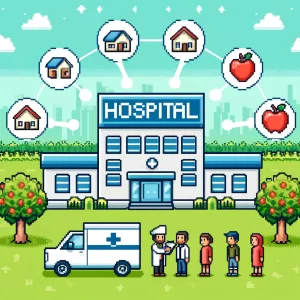
How Addressing Food and Housing Insecurity Can Transform Public Health
When we think about healthcare, most of us picture doctors, hospitals, and medications. But what if I told you that some of the most powerful health interventions have nothing to do with medicine? Across the country, communities and health organizations are exploring a new frontier in public health, one that focuses on the social conditions we all live in—otherwise known as Social Determinants of Health (SDOH). From food insecurity to housing instability, addressing these everyday challenges could be the key to not only improving health outcomes but also saving healthcare dollars.
In a recent study, researchers took a deep dive into the effectiveness of SDOH interventions, focusing specifically on food and housing insecurity. These two factors, often overlooked in healthcare strategies, play a huge role in determining whether someone will stay healthy or fall ill. More than just looking at the feel-good outcomes of these programs, the researchers set out to quantify the return on investment (ROI) of addressing food and housing insecurity. Their findings reveal some exciting possibilities for public health practitioners, policymakers, and even healthcare investors.
So, what exactly is the ROI for food and housing programs? And why should we care? Let’s break it down.
Food and Housing Insecurity: More Than Just a Social Issue
You may have heard the term Social Determinants of Health (SDOH) before, but what does it really mean? SDOH are the conditions in which we are born, grow, live, work, and age. These conditions, like access to healthy food or safe housing, significantly affect our health and well-being. For example, someone who doesn’t have a reliable source of nutritious food is more likely to suffer from chronic illnesses like diabetes or heart disease. Similarly, living in unstable or unsafe housing can increase stress, lead to poor mental health, and limit access to healthcare services.
Public health experts and government agencies have been increasingly focusing on SDOH as a way to reduce health inequities and improve population health outcomes. But here’s the catch: while we know that addressing these issues is crucial, there hasn’t been much research on the financial returns of such interventions. In other words, how much money could we save by helping people secure food or stable housing?
Calculating ROI: The Numbers That Matter
In the recent study, researchers aimed to put a number on the benefits of food and housing interventions by calculating the return on investment (ROI). This is a critical metric for decision-makers who want to know if these programs are worth the effort and funding. ROI is calculated by comparing the net benefits of an intervention (such as reduced emergency room visits) to its costs.
Here’s where things get interesting: the average ROI for food insecurity interventions was 85%. That means for every dollar spent, 85 cents were saved in healthcare costs. Housing insecurity interventions had a lower, but still impressive, ROI of 50%, meaning half of every dollar spent was recouped in healthcare savings.
These aren’t just numbers on a page—they represent real improvements in people’s lives. For instance, medically tailored meal programs helped patients with chronic diseases like heart failure avoid costly hospital visits. Meanwhile, supportive housing initiatives provided safe living environments for people transitioning out of homelessness, leading to fewer emergency room visits and better overall health outcomes.
Why ROI Matters for Public Health
At first glance, you might wonder why public health practitioners should care about ROI. After all, isn’t improving people’s lives and health the main goal? While that’s certainly true, understanding the financial impact of these interventions helps make the case for more widespread adoption. It’s not just about compassion—it’s about showing that these programs can be cost-effective.
For Medicaid programs, which often have tight budgets, proving that food and housing interventions can save money is a game-changer. In fact, some states are already using Medicaid dollars to fund these types of services. For example, Medicaid Managed Care Organizations (MCOs) in several states now offer evidence-based food and housing interventions to high-need populations. By continuing to demonstrate the financial benefits, we can push for more of these innovative approaches to become the norm in public health.
Moving Forward: How to Make SDOH Interventions More Effective
While the study provides valuable insights into the ROI of food and housing programs, it also highlights some challenges. Out of an initial pool of 159 studies, only 19 provided enough data to calculate ROI. This suggests that more research is needed to fully understand the financial and health impacts of these programs. It also underscores the importance of developing standardized reporting practices for SDOH interventions so that future studies can be more easily compared.
Additionally, the study found wide variations in ROI depending on factors like the target population and program duration. For example, some food insecurity programs ran for six months, while others lasted for two years. These differences make it clear that there’s no one-size-fits-all solution when it comes to addressing SDOH. The best approach will depend on the specific needs of the population and the resources available.
But perhaps the most exciting takeaway from the study is the potential for innovative financing solutions. One promising idea is the use of social impact bonds, which allow private investors to fund SDOH interventions upfront, with the promise of repayment if the programs achieve their goals. This could provide much-needed capital for scaling up successful interventions, allowing them to reach more people and make an even bigger impact on public health.
Join the Conversation
What are your thoughts on using ROI to measure the success of public health interventions? Have you seen food or housing insecurity programs make a difference in your community? Share your thoughts, experiences, or ideas in the comments below or on social media!
Be Part of the Change – Get Weekly Updates!
Stay informed and connected. Subscribe for free and share this blog to make a difference in public health with others. If you liked this blog, please share it! Your referrals help This Week in Public Health reach new readers.



